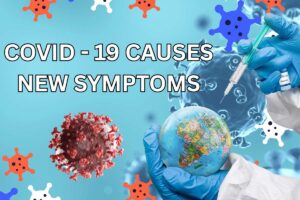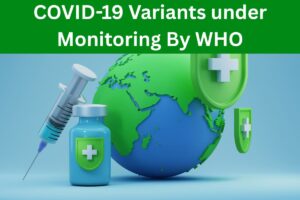By 2025, the world has made leaps, in reality, COVID-19 drives home the point of just how unpredictable life is. Just when we think it is over, a new strain emerges that is even more infectious, harder to detect, and poses new challenges. Due to a newly created Omicron subtype called SARS-CoV-2 Variant 2025, the number of Covid cases in India is now gradually increasing once more. Even though the symptoms are usually less severe, there was little time to relax. If you or someone you care about is not feeling well, knowing the latest symptoms, testing, treatment, and prevention for the latest COVID variant is essential, and all the information you require to stay ahead of the curve is contained in this guide.


SARS-CoV-2 Variant 2025
The SARS-CoV-2 Variant 2025 is also called “Nimbus”. After it was first discovered in January 2025, it has rapidly spread across several nations such as China, India, the US and numerous European countries. Transmission rose sharply, with more than 10 per cent of all COVID-19 cases globally being attributed to the variant by May 2025. Its spread was so rapid that it was classified as a Variant Under Monitoring by the World Health Organization.
Certain mutations in NB. 1. 8. 1 gain transmissibility and partly escape immunity afforded through previous infections or vaccinations. While it is spreading rapidly, the variety does not appear to cause more severe sickness than prior Omicron strains. Though some have reported some new nuances to common symptoms such as a “razor-blade” sore throat, for instance, more commonly reported in the BA.5 era the overall symptoms tend to be the same. Antiviral drugs are still working against the virus and vaccines are still effective in protecting against severe disease.

SARS-CoV-2 Covid Variant 2025
| About | SARS-CoV-2 Covid Variant 2025 |
| Symptoms | Mild to moderate;sore throat, fatigue, dry cough |
| First Detected | Early in 2025 in Southeast Asia |
| Transmission Rate | High |
| Immune Escape | Partial, reduce effectiveness of past infection and some vaccines |
| Category | News |
| Testing Effectiveness | RT-PCR and updates antigen tests still effective |
SARS-CoV-2 Variant Symptoms 2025
Here we disclose various symptoms of this new Covid Variant:
- Sore Throat
- Dry Cough
- Fatigue or Unusual tiredness
- Headache(mild to moderate)
- Runny or stuffy nose
- Loss of smell and taste

How To Diagnose SARS-CoV-2 Variant 2025
- RT-PCR Test (Gold Standard): Identifies the presence of viral genetic material, including the unique new 2025 variant.
- Rapid antigen test: Faster results; used for preliminary screening but lower sensitivity than RT-PCR.
- Genome sequencing: Determines the exact variant (variant including 2025 strain); performed in reference labs
- Chest CT Scan: Useful for discovering pneumonia due to COVID, particularly in symptomatic or hospital patients.
- Antibody Test– Serological Test: An antibody test, or serological test, is used to determine if a person was previously infected; it does not confirm current infection.
- Symptom Check: Utilize as an initial filter, e.g., fever, cough, lethargy, sore throat, etc. but NOT as a confirmation assistant
- Wastewater Surveillance (Yes, It Is a Community Level Test): Indicates presence of virus variants in sewage systems, and is not done for individual diagnosis.
Prevention is Always Preferable To Cure
- Hand hygiene: Use an alcohol-based hand sanitizer or develop the practice of regularly washing your hands with soap and water.
- Masking Up: It’s a good idea to wear masks in enclosed or busy areas, particularly if you’re among vulnerable people or feeling a little ill.
- Avert Congested Areas: Avoid needless exposure, especially if you belong to a high-risk category.
- Ventilation: When indoors, make sure there is adequate airflow. Whenever feasible, open the windows.
- Isolation: If you test positive with COVID-19 or even think you may have it, you need to isolate yourself in order to prevent its spread.
- Keep Up with Vaccinations: Find out from your doctor if you qualify for the most recent booster shots.

SARS-CoV-2 Variant Cases 2025
Initial Description: January 2025, Asia (China, Hong Kong).
WHO Current Status: Variant Under Monitoring (VUM) since May 23, 2025.

Affected Areas: In over 22 countries — U.S., U.K. (all over the UK-wide UK), India, Japan, France, Spain, Thailand, Singapore.
Rise in Proportion:
- By the end of April 2025: the cases were counted 2.5%.
- By Late May 2025: Up to 21% of the world’s cases.
- August 2025: 24% global market share achieved.
FAQs SARS-CoV-2 Variant 2025
It falls under the category of Variant Under Monitoring (VUM).
It has been found in more than 22 nations worldwide.
No, it doesn’t result in more serious sickness.
bodily aches, cough, fever, exhaustion, and sore throat.
Yes, compared to earlier subvariants, it is more transmissible.
There hasn’t been any significant increase in hospitalizations.
As of August 2025, it is responsible for over 24% of all COVID-19 cases worldwide.
